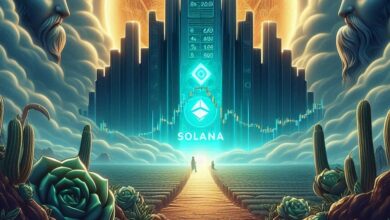Solana: The Rising Star for Euro Stablecoins Amidst Regulatory Shifts

Introduction
The adoption of euro-backed stablecoins has been an uphill battle, but the introduction of the Markets in Crypto-Assets Regulation (MiCA) could signal a significant shift. Stablecoins pegged to the euro, while not as popular as their dollar counterparts, are making headway, especially as they find integration into networks like Solana. One notable development is the launch of SG Forge’s EUR CoinVertible (EURCV) on the Solana blockchain. This integration promises faster transactions, reduced fees, and scalability, but the big question remains—can MiCA help euro stablecoins finally gain the adoption they seek?
SG Forge Launches EURCV on Solana
SG Forge, a cryptocurrency division of Societe Generale, has taken a significant step by launching its stablecoin, EURCV, on Solana. EURCV, a euro-pegged stablecoin, was first introduced on Ethereum last year. However, this latest move to Solana signals a push for greater accessibility, efficiency, and adoption, particularly among institutional and retail users.

The Solana blockchain, known for its fast transaction speeds and low fees, offers an ideal platform for EURCV to expand its reach. With the integration into Solana, EURCV users can now experience the benefits of decentralized finance (DeFi) with enhanced speed, lower costs, and greater scalability, making it a more attractive option for users across various sectors.
Why Solana?
Solana’s integration of EURCV highlights the network’s growing ecosystem for stablecoins. Solana has rapidly gained popularity due to its scalability, which supports faster transaction times and lower costs than many other blockchains, including Ethereum. For SG Forge, the decision to launch EURCV on Solana allows the stablecoin to tap into a more scalable and efficient system, which is particularly crucial for institutional and retail users.
According to Nick Dukoff, Head of Institutional Growth at Solana Foundation, the addition of EURCV to Solana is a welcome enhancement to the ecosystem. The move offers users a stable, euro-pegged digital currency that complies with the upcoming MiCA regulations, combining speed, stability, and efficiency.
The Growth of Solana’s Stablecoin Ecosystem
The launch of EURCV on Solana isn’t an isolated event but rather part of a broader trend. Solana’s stablecoin ecosystem has seen significant growth in recent months, with total market value reaching around $3.79 billion, according to DeFi Llama. Notable stablecoins such as Tether (USDT), Ondo (USDY), and Ethena (USDe) have also been expanding on Solana, contributing to its rise as a key player in the stablecoin space.
Solana’s scalability is a driving factor behind this growth. As stablecoin issuers prioritize networks that offer fast, low-cost transactions, Solana is emerging as an attractive alternative to Ethereum. PayPal, for instance, chose Solana as the launch platform for its stablecoin PYUSD, citing the network’s superior transaction speeds and lower fees compared to other blockchain platforms.
The Struggle for Euro Stablecoin Adoption
Despite these advancements, euro stablecoins have struggled with widespread adoption. EURCV’s initial launch on Ethereum provides a clear example. According to Etherscan data, EURCV has only 28 holders and a total supply of 33 million, indicating slow adoption rates. This challenge isn’t unique to EURCV, as euro-backed stablecoins in general have faced hurdles in gaining traction.
Read more Solana’s Resurgence: A Turning Point in Its Market Journey
Data from DeFi Llama reveals that Circle’s EURC, the largest euro stablecoin by market cap, has a circulating supply of just 52.61 million, followed by Statis EURS at 43.68 million. These numbers pale in comparison to dollar-pegged stablecoins like USDT and USDC, which have enjoyed much broader adoption.
Could MiCA Be a Game Changer?
One of the key factors that could alter the course for euro stablecoins is the forthcoming implementation of MiCA regulations. The new regulations are expected to provide a clear framework for the issuance and use of stablecoins within the European Union. MiCA introduces a specific classification for stablecoins, referred to as “Electronic Money Tokens” (EMTs), which are expected to bring more structure and oversight to the market.
Experts, including Circle EU Policy Manager Patrick Hansen, believe that MiCA could provide the regulatory clarity needed for euro stablecoins to flourish. MiCA will help address concerns around transparency, security, and regulatory compliance, making stablecoins a more viable option for businesses and consumers in the region. For EURCV and other euro-pegged stablecoins, this could be the catalyst needed to finally achieve mainstream adoption.
Conclusion
The integration of EURCV into Solana is a significant development in the stablecoin space, offering users a fast, low-cost, and scalable option for transacting in euro-backed digital assets. Solana’s expanding ecosystem for stablecoins, driven by its technical advantages, is positioning it as a key platform for stablecoin adoption.
However, euro stablecoins like EURCV still face challenges in gaining widespread use, particularly when compared to their dollar-backed counterparts. The introduction of MiCA could be a turning point, providing the regulatory framework needed to build confidence and drive adoption in the euro stablecoin market. Whether MiCA will indeed unlock the potential of euro-pegged stablecoins remains to be seen, but the future looks promising for those willing to take the leap into this evolving space.
Important Notice: The content presented in this article is intended for informational purposes only and should not be interpreted as financial advice. Coinshibainu.com bears no responsibility for any investment decisions made relying on the information contained herein. It is highly recommended to consult with a qualified expert or financial advisor before making any investment decisions.



